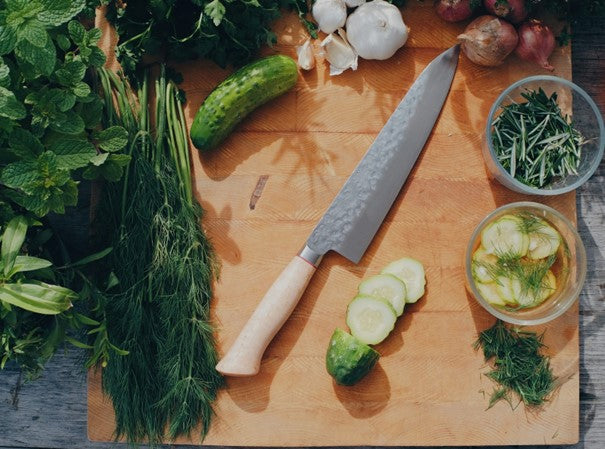What you should pay attention to when buying
size and weight
The size and weight of a knife should suit your personal style and the tasks you do in the kitchen. A heavier knife may be helpful for tough cutting tasks, while a lighter knife may be easier to handle for delicate cutting tasks. Find the right balance that suits your hand size and work style.
balance
A well-balanced knife allows for precise cuts with minimal effort. The balance should be perfectly balanced between the blade and the handle so that the knife is neither top-heavy nor handle-heavy. This reduces the strain on your hand and improves control of the knife.
ergonomics
The handle should be ergonomically designed and fit well in your hand to maximize comfort and control. Make sure the handle is suitable for your hand size and does not have any sharp edges or uncomfortable pressure points. An ergonomic handle can significantly reduce fatigue during longer preparations.
brands and craftsmanship
Choosing a reputable brand not only guarantees the quality of the materials, but also the craftsmanship that went into making the knife. Well-known brands are often known for their exceptional manufacturing and attention to detail, resulting in a product that is both functional and aesthetically pleasing.
price-performance ratio
While high-quality knives require a larger initial investment, they pay off in the long run with durability and consistent performance. It's better to invest in one or two high-quality knives that will meet all your kitchen needs than a cheap set that will need to be replaced quickly.
recommendations and example sets
At QUAMA you will find a selection of exquisite kitchen knives known for their exceptional quality and craftsmanship. Here are some recommendations that are perfect for both beginners and professionals:
– Nesmuk EXKLUSIV C150 chef's knife: This knife is a true masterpiece of blacksmithing, made of Damascus steel with a unique blade structure. It combines the highest sharpness with exceptional hardness and is ideal for anyone looking for a knife of outstanding quality.
– Nesmuk JANUS Santoku knife: With its easy-to-handle, wider blade, this Santoku knife is perfect for precise cuts and versatile uses in the kitchen. The blade is made of high-performance stainless steel with a DLC coating that ensures extremely high cutting ability.
– Nesmuk SOUL paring knife: This small but powerful knife is ideal for fine work such as peeling and carving fruit and vegetables. The blade is made of high-alloy carbon steel, which ensures maximum sharpness and durability.
Example combinations: knife sets for different needs
– For beginners: A set consisting of a Nesmuk EXKLUSIV C150 chef's knife and a Nesmuk SOUL paring knife offers a solid foundation for all basic cutting tasks in the kitchen. This set allows you to learn the essential cutting techniques while enjoying the benefits of high-quality knives.
– For professionals: A set of the Nesmuk JANUS Santoku knife, the Nesmuk EXKLUSIV C150 chef's knife and a boning knife is ideal for experienced chefs who need to cover a wide range of cutting tasks. This set offers precision, versatility and the sharpness needed for demanding tasks.
– For meat lovers: A set consisting of a boning knife and the Nesmuk SOUL paring knife offers the perfect combination for those who often work with meat. The boning knife ensures clean cuts and efficient work on the meat, while the paring knife offers precision for fine work.
Conclusion
A good kitchen knife is the heart of a well-equipped kitchen. It not only offers precision and efficiency, but also safety and durability. Choosing the right knife - be it a chef's knife, santoku knife or paring knife - depends on your individual needs. High-quality materials such as stainless steel, carbon steel or damask steel and ergonomic handles made of wood, plastic or stainless steel contribute to performance and durability.
Recommendation: Invest in quality
Invest in high-quality knives that will not only give you a better cooking experience, but will also remain reliable for years to come. Proper knife care and selection will pay off in the long run and make every meal a pleasure.
“The right knife makes the difference between a chef and a master.”
– Wolfgang Puck, Austrian-American chef and restaurateur




